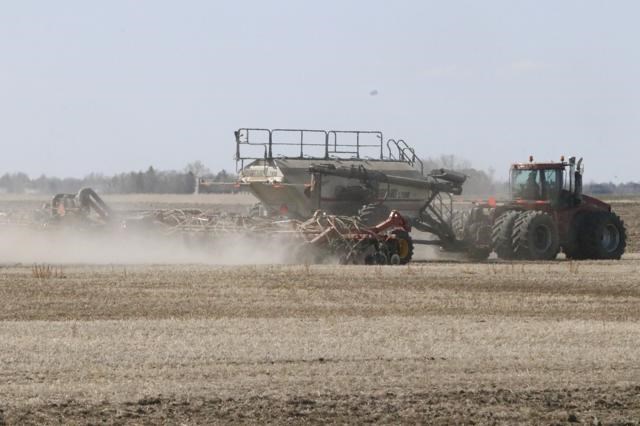Seeding has begun in a few areas around Weyburn, Frobisher, Moosomin and Grenfell. Most farmers have been able to get into the fields to do some weed control and fertilizer applications. A cool and late spring has delayed field work across the province. Most other areas have some field activity with harrowing, pre-seeding herbicide and fertilizer applications.
One producer who has been out in the fields is Marcel Van Staveren, who farms with his two brothers in the Creelman area. As of Monday, they were about 30 per cent completed seeding, starting off with durum and hard red spring wheat.
One factor to the seeding has been the level of soil moisture, which Van Staveren said is surprisingly good at this point, but is dry for the long-term.
“It’s actually quite ideal on most stubble, but on flax and soybean stubble it’s starting to be a little dry,” he said, and pointed out one issue for some crops is the seeds weren’t planted deep enough.
“Under dry conditions, you have to be planting deep enough in case the surface doesn’t get replenished,” he said, noting that in past years, they start to look for showers towards the end of May when moisture is needed to help give a boost to the seeded crops.
For his area, it’s been almost 11 months since they’ve received any decent amount of moisture, which affects the moisture in the subsoil levels.
“Usually I can push my soil moisture probe about four feet. This year, there is about 18 to 24 inches of reasonable surface moisture, but it’s dry below that, and that area below is what we need to pull us through July and August. That’s my concern, so hopefully we’ll get some moisture,” said Van Staveren. “In the next seven to 10 days, things could get quite real if we don’t get any rain.”
He plans on seeding canola a little later than normal, and expects to start planting it by this weekend, hoping that he can avoid the danger of spring frost which has hurt his canola crops in recent years.
“We find it’s less risky and we might save a bit of money by not losing some seed. However, canola should be seeded shallow, so we’re taking a risk as we seed a little later in May,” said Van Staveren, noting some people want to get canola planted now to capture any residual moisture in the soil.
If seeding conditions continue as they are now, he said they will need most of the month of May to finish all of the seeding. One benefit of the dryness so far is there hasn’t been much weed growth or pests appearing yet.
Rain showers were reported in most areas in the southeast, but rainfall has been small since April 1, as RMs like Tecumseh, in the Stoughton region, and parts of the RM of Laurier in the Radville region, have recorded no rainfall so far, while a second reporter in Laurier noted they have received 6 mm so far this spring.
The RM of Weyburn has had 2 mm since April 1, Brokenshell has had 5 mm, Wellington has had 7 mm, and the RM of Francis has had rainfall ranging from 7.5 to 10 mm. The RM of The Gap had a rainfall of 8.8 mm last week, with a total of 11 mm since April 1.
Cropland topsoil moisture is rated as 47 per cent adequate, 39 per cent short and 14 per cent very short. Hay land and pasture topsoil moisture is rated as 34 per cent adequate, 48 per cent short and 18 per cent very short. Even though spring seeding is late, producers have indicated the soil is drying up and a rain would not be unwelcome.
Cool weather has slowed pasture and weed growth in many areas. It is too soon to assess winter wheat survival.
Farmers are busy seeding, working fields, calving, fixing fences and controlling weeds.
Field conditions vary greatly across the province. The southern regions are dry and the northern and eastern regions are dealing with higher field moisture conditions. Due to a low yielding hay crop in 2017, an extended cold winter, and a slow start up to spring, many livestock producers are feeding alternative feed sources and feed grains, while they wait for the pastures to green up. Spring runoff in the south was below normal in many areas, leaving some livestock producers looking at how to sustain water supplies throughout the upcoming grazing season.




